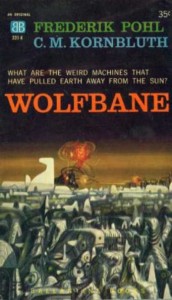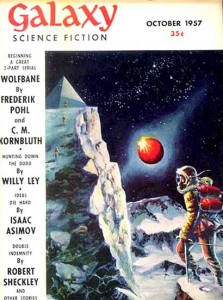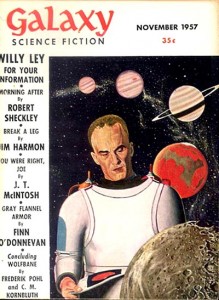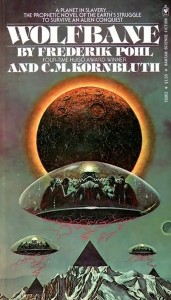Return to Introduction
Return to The Space Merchants
Return to Search the Sky
Return to Two Solo Novels: The Syndic and Drunkard’s Walk
Return to Gladiator-at-Law
Return to the Collaborative Short Fiction
Wolfbane
by Frederik Pohl and C. M. Kornbluth
Original publication: October, 1957 and November, 1957 issues of Galaxy Science Fiction (as two-part magazine serial)
Ballantine Books, 1959 (simultaneous hardback and paperback, expanded version of Galaxy serial)
Most recent publication: Orion/Gollancz Science Fiction, 2000 (paperback); Wonder eBooks, 2008 (Kindle edition)
************************
Wolfbane was the fourth and final of Frederik Pohl’s and Cyril Kornbluth’s novel-length collaborations in science fiction. Due to the unique history of its composition – it was essentially written in phases, with three separate versions eventually seeing publication – it offers a particularly clear window into what Cyril Kornbluth added to the mix. Given that Frederik Pohl himself has admitted that he can’t remember with any degree of accuracy the extent of his contributions and Kornbluth’s contributions to their shared novels, at least in terms of sorting out who was responsible for introducing particular characters or plot elements, giving Wolfbane a close look promises to be an illuminating exercise.
Here is what Pohl had to say about the genesis of Wolfbane in his Introduction to the first collection of Pohl-Kornbluth short fiction, The Wonder Effect: “Wolfbane was a different sort of story. We planned it as a 15,000 word novelette—and wrote it that way, too, turn and about. But it was almost unreadable, far too telegraphic and compressed; and I opened it out to about 40,000 words, in which form it was published as a magazine serial; whereafter Cyril expanded it to about 60,000 words for the final book version. This was about the last writing Cyril did before his death.”
Wolfbane has been published in three versions: the two-part magazine serial published in the October and November, 1957 issues of Galaxy; the longer version (fifty percent longer than the magazine version) published in book form by Ballantine in 1959; and a third version, expanded and revised by Pohl for publication by Baen Books in 1986, during a period when Pohl was going back to each of his SF collaborations with Kornbluth and revising it.
Based upon the above information, it’s possible to read the 40,000 word Galaxy version and the 60,000 word 1959 Ballantine version back to back, determine which 20,000 words were added between the former and the latter, and ascribe those words to Cyril Kornbluth. And, being the obsessive fan that I am, that is what I did. In this way, Wolfbane can almost serve as a sort of Rosetta Stone for the Pohl-Kornbluth collaboration, putting to rest (if it still needs putting to rest) Kingsley Amis’s assertion from his 1960 work of criticism, New Maps of Hell, that all of the “good stuff,” the social and political extrapolation and satire, in the Pohl-Kornbluth collaboration came from Frederik Pohl, with Cyril Kornbluth only contributing the pulpier, more action-oriented material. (See my assessment of Amis’s assessment here.)
To the best of my knowledge, the initially published, 40,000 word version of Wolfbane has never been republished since it first appeared in 1957 in Galaxy. However, thanks to my friends at Books From the Crypt, an online store specializing in SF pulps and rare paperbacks, I was able to acquire the two issues of Galaxy at a reasonable price.
The entirety of the first portion of the serial from the October, 1957 issue was inserted pretty much unchanged and unexpanded into the 1959 book version, along with about the first quarter of the second installment, from the November, 1957 issue. The Galaxy version and the 1959 Ballantine Books version are indistinguishable to my eyes (apart from a few relatively minor revisions noted below) to the point in the story where Glenn Tropile, the book’s Wolf/Citizen protagonist, awakens on the binary planet which has stolen Earth from its orbit, embedded in a tank of nutrient liquid by the Pyramid aliens as one-eighth of a human computer. From that point forward, the two versions of Wolfbane differ considerably, although they share an identical ending (an ending which is granted much greater emotional power by Cyril Kornbluth’s additions to the second half of the 1959 Ballantine version).
Just a quick word on some peculiarities of the Galaxy version – the haste with which Pohl and Kornbluth wrote it and with which editor Horace L. Gold edited it are apparent. The two-part serial contains numerous typographical errors, as well as a pair of minor but nonetheless irritating story errors. The worst of these was having Gala Tropile, Glenn Tropile’s wife, translated/transported to a storage unit on the binary planet, then later appear in Citizen Roget Germyn’s house on Earth, prior to the warfare on the binary planet, won by the Earthmen, which allows the people abducted by the Pyramids to return to Earth. The lesser error was describing several activities of the Pyramids taking place on Earth’s moon, rather than on the binary planet where they must have taken place (every five years, the Pyramids ignite Earth’s moon into a small facsimile of the sun, in order to maintain livable conditions for the humans on Earth while Earth is being dragged through interstellar space by the binary planet’s propulsion system; so, apart from somehow lighting a series of fusion reactions on the moon’s surface, the Pyramids do not carry out any of their activities there). All of these errors were corrected for the 1959 book publication.
Wolfbane is “big picture” science fiction, futuristic adventure on a grand canvas. At the book’s start, seven eighths of the human race have died out, due to continual environmental catastrophes caused by the Earth’s removal from its orbit around the sun by alien invaders (only one of which actually resides on Earth, atop the shaved-off peak of Mount Everest, the rest of the Pyramids remaining on their binary planet, upon which they have installed propulsion machinery capable of moving that planet, Earth, and Earth’s moon through space as a mini-solar system). As mentioned above, every five years the Pyramids ignite the moon to serve as a miniature substitute for the sun, but the moon’s radiance quickly declines and eventually it burns out, necessitating another ignition. In the meantime, ice sheets have retreated and then advanced across Earth’s land surfaces, and the seas have expanded and then shrunk, causing havoc for humanity’s efforts at agriculture and forcing the shrunken, dispirited remnants of humanity to continually migrate, keeping abreast of the advancing and then retreating ice sheets. The purposes of the alien Pyramids are a complete mystery to humanity. No Pyramid ever attempts to communicate with any human. Pohl and Kornbluth do a brilliant job of portraying the type of society which might emerge from such conditions. In North America, society has reverted to bare subsistence farming and social norms very much akin to those of pre-modern Japan. Barely surviving on about five hundred calories of food intake per day, Citizens constrain their movements and indulge in arts requiring the most minute expenditures of energy, such as elaborate rituals of politeness, hospitality, eating, and meditation. Meditation is considered one of humanity’s highest pursuits. The culmination of the purest form of meditation is “translation,” or a visitation by a shimmering eye-like visage, followed by the sudden vanishing of the meditator. Any persons who display unusual initiative or selfishness or who try to utilize advanced technologies left over from the pre-Pyramid era are denounced as Sons of the Wolf, captured, and executed by draining their spinal fluid.
The novel’s protagonist, Glenn Tropile, is a Wolf who has been trying to act out the part of Citizen his entire life. However, during a crisis in his village, his mask slips, and he is caught pilfering extra rations of food. He is caught and sentenced to having his spinal fluid drained, but he manages to utilize both his intimate knowledge of Citizen social mores and his psychological hold over his wife to escape prison and execution. Once he is outside his village, he is picked up by a helicopter operated by members of a secret village of Wolves. These Wolves have been recreating the weaponry of pre-abduction Earth and carry out expeditions to Mount Everest at the beginning of each five-year moon-sun cycle to gather intelligence on the Pyramid sitting on the summit. Their ultimate goal is to wrest control of the Earth back from the alien Pyramids and to return Earth to its orbit around the sun. Tropile’s new comrades warn him not to practice meditation, as that activity is strongly associated with the appearance of shimmering eye visages and subsequent translation, or disappearance. However, one day while he is harvesting crops, Tropile takes a lunch break and ends up inadvertently falling into a meditative state while observing his pot of water boil over an open fire. An “eye” appears above him, and while some of the other Wolves watch, Tropile is translated and disappears. The Pyramid atop Mount Everest, noting that Tropile has cleared his mind of all thought, registers that he is ripe for harvesting and instantaneously transports him to a holding tank on the binary planet. There he is surgically “wired together” with seven other humans to form one of the Pyramids’ numerous biological computers, which they utilize to run all of the complex machinery on the binary planet, including the planet’s propulsion system and the feeding booths the Pyramids need in order to survive. The purpose for the Pyramids’ abduction of Earth was to secure a supply of components for their biological computers. Once that supply has been completely harvested and used up, the Pyramids will abandon their hold on Earth and locate another planet occupied by suitable life forms for them to harvest.
At this point in the story, the two versions diverge. Readers concerned about “spoilers” should skip to the last paragraph of this essay. I apologize, but it is virtually impossible to talk about two versions of the final third of a novel without giving away a good bit (if not all) of the climax. The earlier version comes to its climax when Tropile manages to awaken and organize his fellow seven nutrient tank dwellers, and they use their control over various mechanical and chemical processes on the binary planet to trick the Pyramids into transporting six hundred Wolves and Citizens from Earth who are known to Tropile to the binary planet, along with weapons from the Wolves’ village. There, rather than being placed into storage for use as computing elements for the Pyramids, Tropile and his allies set the Earth people loose in the tunnels beneath the binary planet to cause mayhem among its myriad of fragile mechanisms. They use the distraction they thus gain to seize control of the Pyramids’ instantaneous transportation mechanism and use it to hurl all of the thousands of Pyramids on the binary planet’s surface onto the burning surface of the moon, where they are destroyed.
Given the task of expanding the novel by 20,000 words for book publication, Cyril Kornbluth opted to change this sequence of events in a number of very interesting ways. In the earlier version, Pohl and Kornbluth gave a name and background to only one of the seven individuals Tropile finds himself sharing a nutrient tank with. Kornbluth opted in his expanded version to flesh out the identities of all of other seven “computing elements,” having them originate in various regions and continents of Earth still inhabited by humans and giving them widely disparate personalities and histories. In doing so, he offered a vivid portrait of a gestalt consciousness, on par with what Theodore Sturgeon had so memorably accomplished in his novel More Than Human (1953), which must have influenced Kornbluth. Kornbluth also portrays a much more fascinating picture of the interplay between this gestalt consciousness and the hundreds of human beings it causes to be transported from Earth to the binary planet. Rather than simply give them weapons and have them attack the Pyramids’ machines, the gestalt consciousness manipulates them, through alternating periods of satiety with periods of hunger and thirst, into becoming “mice” inside the tunnels and automated factories of the binary planet, causing continual destruction through their search for food and water. Kornbluth also included a scene wherein the separate personalities of the gestalt consciousness disaggregate themselves, and some, including Tropile, express horror at the callousness with which they have used their friends and relatives as tools, fomenting a brief but intense conflict among the eight partners and adding a new layer of psychological and moral complexity to the novel.
Another major change that Kornbluth made was to give the alien Pyramids a backstory. In the novel’s second version, rather than there being tens of thousands of Pyramids, there are only eight. The Pyramids were constructed thousands of years ago as mechanical servitors by a biological race which once inhabited the binary planet. The eight most powerful and invincible of these were designed to explore the stars. While they were carrying out their mission of interstellar exploration, the more mundane Pyramids turned on their creators, nearly wiping out the biological population before the creators managed to destroy their rebellious creations. However, when the eight super Pyramids returned and found that their brethren had been wiped out, they eradicated the remainder of their creators, leaving only one to hover between life and death, which they preserved in a sort of stasis in a chamber located on the binary planet’s north pole. Tropile’s gestalt consciousness manages to contact this one remaining Pyramid creator and convinces it to share its unique knowledge of the Pyramids’ weaknesses in order to defeat the eight super Pyramids.
In contrast to the cursory, summarized battle portrayed in the initial version of Wolfbane, the struggle portrayed in the 1959 version is a well thought-out military campaign against the Pyramids. Kornbluth utilized his knowledge of large-scale infantry combat and basic engineering, acquired during his Army service during World War Two, to write a vividly described, massive struggle between the gestalt consciousness and its human allies versus the Pyramids and their robots that spans the entirety of the binary planet. Tropile separates himself from his gestalt partners at great personal sacrifice to lead the human forces on a sabotage mission designed to destroy the Pyramids’ source of nutrients. The mission involves fierce combat against giant repair robots, combat which leaves a third of the human forces dead, but which succeeds in blowing up the central nutrient depository. The Pyramids are then doomed to run down and become inactive, having expended all their energy supplies in an ultimately successful though Pyrrhic attempt to destroy the gestalt.
Kornbluth and Pohl opted to retain their original ending from the Galaxy serial version. However, Kornbluth’s changes and additions to the story give that ending much more emotional heft, as well as more fully supporting and justifying Tropile’s decision to return to a form of gestalt consciousness, despite the deaths of his original seven partners.
The initial version of Wolfbane is an exciting and imaginative apocalyptic thriller that effectively evokes the SF sense of wonder. However, Cyril Kornbluth’s additional 20,000 words elevated it from a good SF novel to a classic SF novel.
Frederik Pohl has opined that, had Cyril Kornbluth lived a longer, more typical lifespan, he would have become one of the all-time greats of science fiction. Those final 20,000 words of Wolfbane were some of the last words that Kornbluth wrote, and they are some of his finest, most powerful, and most fully realized work. Had he continued producing long-form works of the quality of his work on Wolfbane, he would certainly now be at least as well-remembered and well-regarded as Isaac Asimov, Arthur C. Clarke, or Robert Heinlein. Bereft of this what-if, we are left only with his classic short fiction, a flawed but memorable solo novel (The Syndic), and his novel-length collaborations with Frederik Pohl as evidence of his skill and talent as a writer. Count his contribution to Wolfbane as one of the most compelling pieces of that evidence.









A very interesting article. Although I never read the later novel, I did read the Galaxy serial way back when. In 1957 I wasn’t looking for errors, but rather entertainment, and this is what I got from Galaxy. Ah, to be young and discovering science fiction once more!
Tom, thanks so much for the note and for visiting my blog. I’m sure the errors in the GALAXY version of WOLFBANE wouldn’t have jumped out at me the way they did if I hadn’t have read the 1959 book-length version first, and if I hadn’t been on the look-out for differences between the two versions. Just out of curiosity, what year did you begin reading SF, and how old were you?
Hi Andrew, I was an early reader beginning with the classics at age ten in 1950, then by 1952 (age 12) I found science fiction and was hooked for life. I did graduate to other genres, but I’ve always loved science fiction. Favorite authors are A. E. van Vogt, Heinlein, Clarke, Asimov, George O. Smith, and many of the early masters. I also enjoy Burroughs and Howard, of course.
Tom, thanks for sharing a bit on your background. I’ll be posting some looks back at a few of the greatest SF writers of the 1940s-1970s over the coming months, including reviews of books by Philip Jose Farmer, Michael Moorcock, and Fritz Lieber. I hope you’ll continue to visit from time to time!
I very much enjoyed your analysis of WOLFBANE, which I first read in 1959. Kornbluth was one of my first favorites.
Regarding your last comment of having only the great short stories, Pohl collaborations and THE SYNDIC to judge Kornbluth’s skill as a writer, I would add his other SF solo novel NOT THIS AUGUST, which I always thought was superior to THE SYNDIC. I admit it has been many years since I read either.
And if we are speaking of Kornbluth’s skill as a writer and not just a writer of science fiction, I also suggest THE MAN OF COLD RAGES, an intense novel published by Pryamid in 1958 under the name Jordan Park.
Richard, thanks so much for writing, and thanks, too, for your recommendations of a couple of Cyril Kornbluth’s lesser known works. I saw that Kornbluth’s collaborations with Judith Merril were recently reprinted in an omnibus edition; I don’t know whether any of his other novels have been recently reprinted, but I’m sure I can track them down, in time.
(SPOILER ALERT) I have just read Wolfbane, on your recommendation. What a mindbending piece of science fiction! I was staggered throughout by the sheer power of invention, and several times thought: you couldn’t film this, you couldn’t animate this. Only the written word could convey half of what goes on in this book. I think it’s important to bear this in mind when so many new books are merely Hollywood screenplays in gestation. As to the Kornbluth/Pohl question, based on what you have written above, I have to say that my favourite parts of the book were the Kornbluth parts. The basic Pohl premise is pretty good – well, pretty far out crazy, actually, yet completely believable. The part of the book where Trophile joins the collective mind is where the book really takes off however. And, for me, the part where the book leaves orbit, so to speak, is the revelation of the Pyramid backstory, and that far from being the inhabitants of their planet, they are merely out of control constructions of the real inhabitants. That kind of revelation – hinted at, but not overdone – merely leaving you with so many questions which you are burning to find the answer to, is a technique which I associate mostly with Arthur C. Clarke. You’re absolutely right – if Kornbluth was writing like this, then we’ve been deprived of one of the great SF writers, which is an absolute tragedy.
Matthew, I’m so pleased you enjoyed WOLFBANE as much as you did. Having posted an article that got you to read it, I figure my career as a blogger is now justified!
[…] Source: Pohl Plus Kornbluth Part 7: Wolfbane | Fantastical Andrew Fox […]